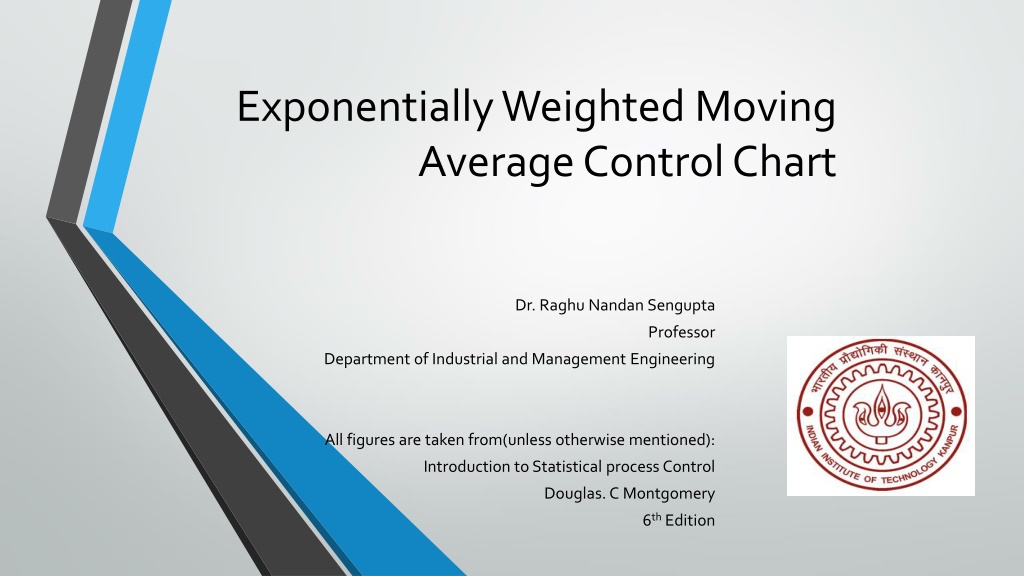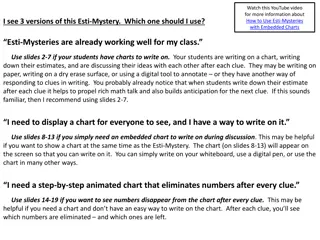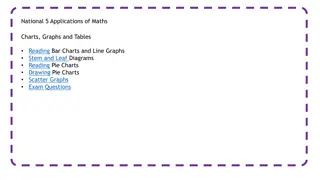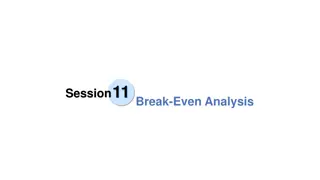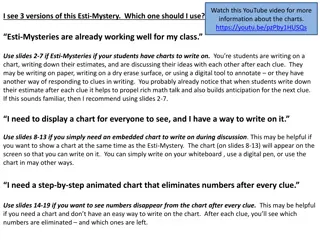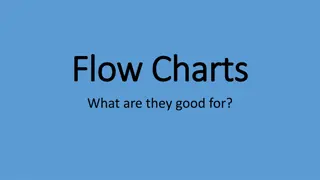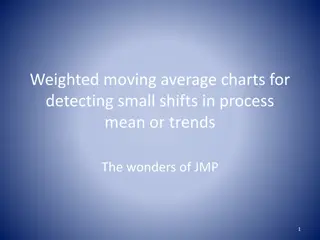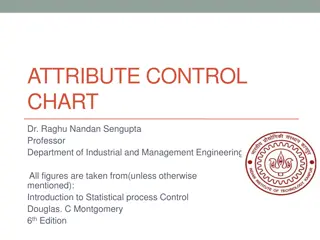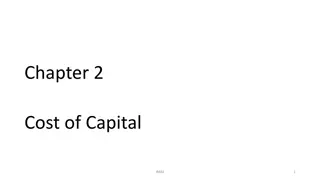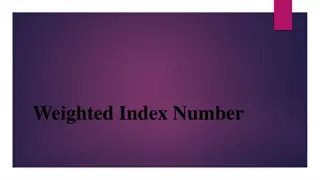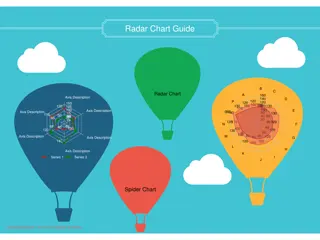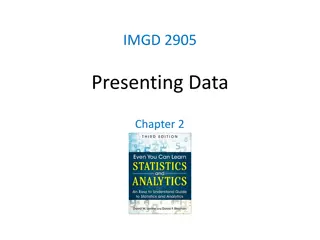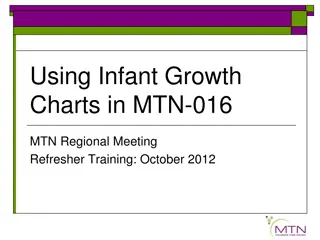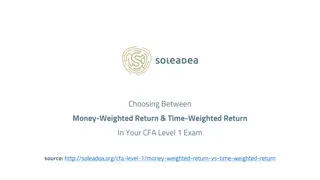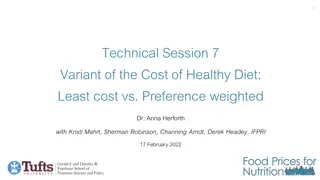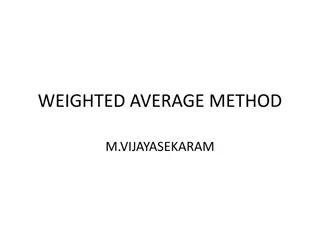Understanding Exponentially Weighted Moving Average Control Charts
Exponentially Weighted Moving Average (EWMA) control charts offer an effective alternative to Shewhart control charts for detecting small shifts in processes. This article explores the definition, properties, and calculations involved in EWMA control charts, providing insights on using this method in statistical process control.
Download Presentation

Please find below an Image/Link to download the presentation.
The content on the website is provided AS IS for your information and personal use only. It may not be sold, licensed, or shared on other websites without obtaining consent from the author. Download presentation by click this link. If you encounter any issues during the download, it is possible that the publisher has removed the file from their server.
E N D
Presentation Transcript
Exponentially Weighted Moving Average Control Chart Dr. Raghu NandanSengupta Professor Department of Industrial and Management Engineering All figures are taken from(unless otherwise mentioned): Introduction to Statistical process Control Douglas. C Montgomery 6thEdition
EWMA Control Chart The exponentially weighted moving average (EWMA) control chart is also a good alternative to the Shewhart control chart when we are interested in detecting small shifts. The performance of the EWMA control chart is approximately equivalent to that of the cumulative sum control chart, and in some ways it is easier to set up and operate. As with the cusum, the EWMA is typically used with individual observations
The EWMAControlChart for Monitoring the Process Mean The exponentially weighted moving average is defined as: where 0 < 1 is a constant the starting value (required with the first sample at i = 1) is the process target, so that z0= 0 Sometimes the average of preliminary data is used as the starting value of the EWMA, so that z0= x The weights (1 )j decrease geometrically with the age of the sample mean. The weights sum to unity
Some properties of EWMA chart Sine the weights decline geometrically when connected by a smooth curve, the EWMA is sometimes called a geometric moving average (GMA) Since the EWMA can be viewed as a weighted average of all past and current observations, it is very insensitive to the normality assumption. It is therefore an ideal control chart to use with individual observations. An example:
The centreand control lines We will discuss how to select L and shortly
Steady State values of control limits The term [1 (1 )2i] in equations (9.25) and (9.26) approaches unity as i gets larger. This means that after the EWMA control chart has been running for several time periods, the control limits will approach steady-state values given by: For better performance, for small values of i, the earlier mentioned equations should be used
Design of the EWMA control chart The design parameters of the chart are the multiple of sigma used in the control limits (L) and the value of . It is possible to choose these parameters to give ARL performance for the EWMA control chart that closely approximates cusumARL performance for detecting small shifts.
TQM-I Raghu N. Sengupta Lecture # 39
Inertia Effect There is one potential concern about an EWMA with a small value of . If the value of the EWMA is on one side of the center line when a shift in the mean in the opposite direction occurs, it could take the EWMA several periods to react to the shift, because the small does not weight the new data very heavily. This is called the inertia effect. It can reduce the effectiveness of the EWMA in shift detection.
Signal Resistance Signal Resistance of a control chart to be the largest standardized deviation of the sample mean from the target or in-control value not leading to an immediate out-of-control signal. For a Shewhart chart, the signal resistance(SR) is SR(x)=L(the multiplier used for calculating control limits) It is constant For the EWMA chart, the SR is defined as: Where w is the required EWMA statistic
Using combination of EWMA and Shewhartchart Like the cusum, the EWMA performs well against small shifts but does not react to large shifts as quickly as the Shewhart chart. A good way to further improve the sensitivity of the procedure to large shifts without sacrificing the ability to detect small shifts quickly is to combine a Shewhart chart with the EWMA. These combined Shewhart-EWMA control procedures are effective against both large and small shifts. When using such schemes, it is helpful to use slightly wider than usual limits on the Shewhart chart (say, 3.25-sigma, or even 3.5-sigma). It is also possible to plot both xi(or ) and the EWMA statistic zion the same control chart along with both the Shewhart and EWMA limits. This produces one chart for the combined control procedure that operators quickly become adept at interpreting. When the plots are computer generated, different colours or plotting symbols can be used for the two sets of control limits and statistics.
Extension of EWMA- Fast initial response feature It is possible to add the fast initial response (FIR) or headstart feature to the EWMA. As with the cusum, the advantage of the procedure would be to more quickly detect a process that is off target at start-up. Two approaches are suggested: Set up two one-sided EWMA charts and start them off at values midway between the target and the control limit Use a single control chart but narrow the time-varying limits even further for the first few sample points an exponentially decreasing adjustment to further narrow the limits, so that the control limits are located a distance of around the target
Continued. In the second method f and a are to be chosen One thumb rule is : a=[ 2/log(1 f) 1]/19. For example, if f = 0.5, then a = 0.3. The choice of f = 0.5 is attractive because it mimics the 50% headstart often used with cusums. Both of these procedures perform very well in reducing the ARL to detect an off-target process at start-up. The second procedure is easier to implement in practice.
Monitoring Variability Let xibe normally distributed with mean and standard deviation . The exponentially weighted mean square error (EWMS) is defined as: If s0 represents the in-control or target value of the process standard deviation, we could plot on an exponentially weighted root mean square (EWRMS) control chart with control limits given by:
Continued. EWMS statistic can be sensitive to shifts in both the process mean and the standard deviation. They suggest replacing min equation (9.27) (the equation of steady state EWMS: )with an estimate at each point in time. A logical estimate of turns out to be the ordinary EWMA zi. They derive control limits for the resulting exponentially weighted moving variance (EWMV) :
EWMA for Poisson Data If xiis a count, then the basic EWMA recursion remains unchanged: with z0= 0the in-control or target count rate The parameters for the control chart are: Here AUand ALare upper and lower control limit factors. In many applications, they AL=AU=A There exists charts which show values and A for a particular chosen value of .
The EWMA as a predictor of Process Level From an SPC viewpoint, the EWMA is roughly equivalent to the cusum in its ability to monitor a process and detect the presence of assignable causes that result in a process shift. However, the EWMA provides a forecast of where the process mean will be at the next time period. That is, ziis actually a forecast of the value of the process mean at time i+ 1 In computer-integrated manufacturing where sensors are used to measure every unit manufactured, a forecast of the process mean based on previous behavior would be very useful. If the forecast of the mean is different from target by a critical amount, then either the operator or some electromechanical control system can make the necessary process adjustment. If the operator makes the adjustment, then he or she must exercise caution and not make adjustments too frequently because this will actually cause process variability to increase. The control limits on the EWMA chart can be used to signal when an adjustment is necessary, and the difference between the target and the forecast of the mean i+1 can be used to determine how much adjustment is necessary..
Continued. The EWMA can be modified to enhance its ability to forecast the mean. Suppose that the process mean trends or drifts steadily away from the target. The usual EWMA equation can be written as: If we view zi 1as a forecast of the process mean in period i, we can think of xi zi 1as the forecast error eifor period i. So: Thus, the EWMA for period i is equal to the EWMA for period i 1 plus a fraction of the forecast error for the mean in period i. Now add a second term to this last equation to give
Continued.. where 1 and 2 are constants that weight the error at time iand the sum of the errors accumulated to time i. If we let ei= ei ei 1be the first difference of the errors, then we can arrive at a final modification of the EWMA: The EWMA in period i(which is the forecast of the process mean in period i+ 1) equals the current estimate of the mean (zi 1estimates i), plus a term proportional to the error, plus a term related to the sum of the errors, plus a term related to the first difference of the errors. These three terms can be thought of as proportional, integral, and differential adjustments. The parameters 1, 2, and 3 would be chosen to give the best forecasting performance.
The Moving Average Control Chart Both the cusumand the EWMA are time-weighted control charts. The EWMA chart uses a weighted average as the chart statistic. Occasionally, another type of time-weighted control chart based on a simple, unweighted moving average may be of interest. let x1, x2, . . . Denote individual collected observations. The moving average of span w at time i is defined as: At time period i, the oldest observation in the moving average set is dropped and the newest one added to the set. The variance of the moving average Miis:
Control Limits Therefore, if 0denotes the target value of the mean used as the centerline of the control chart, then the three-sigma control limits for Miare:
